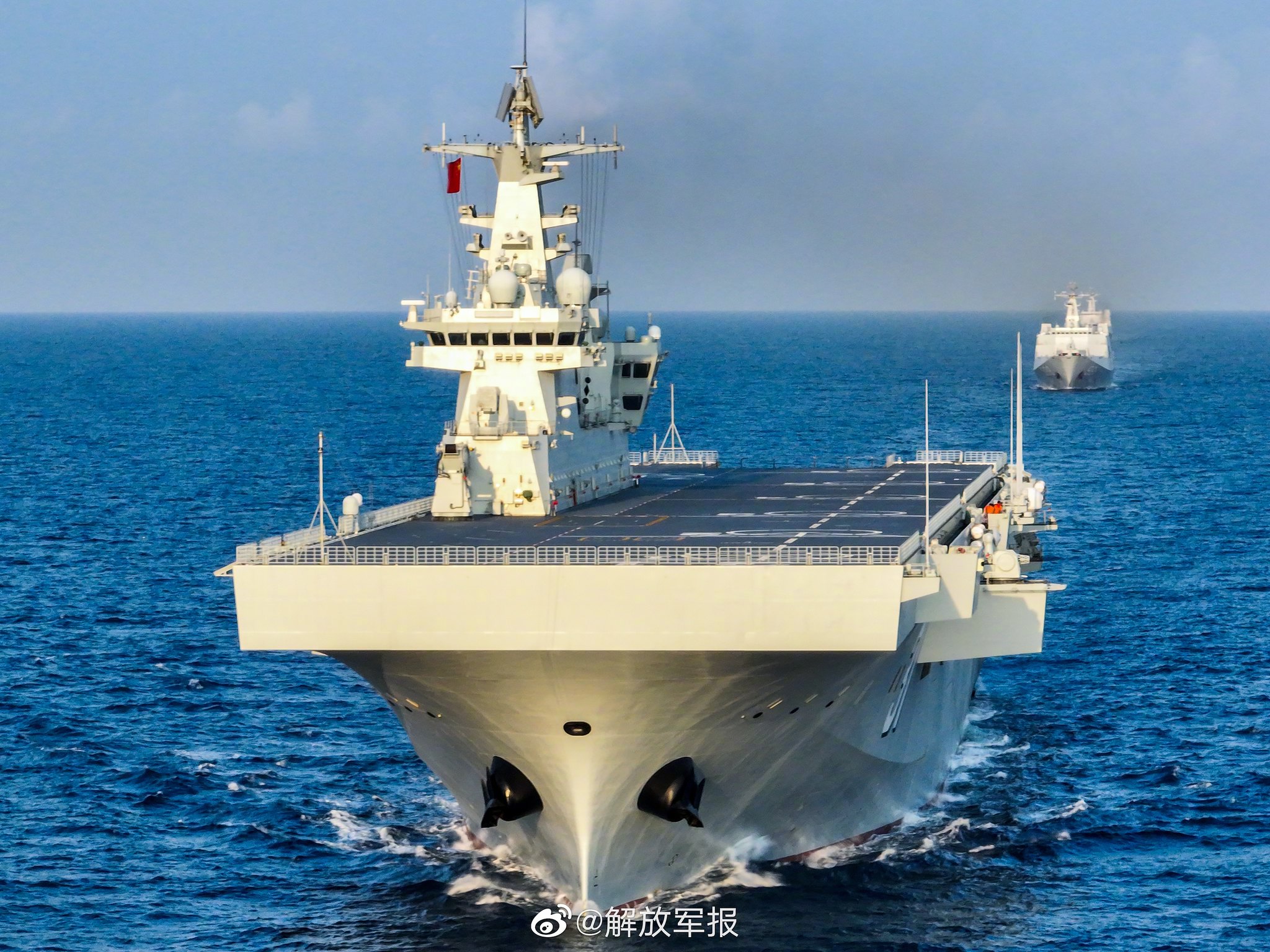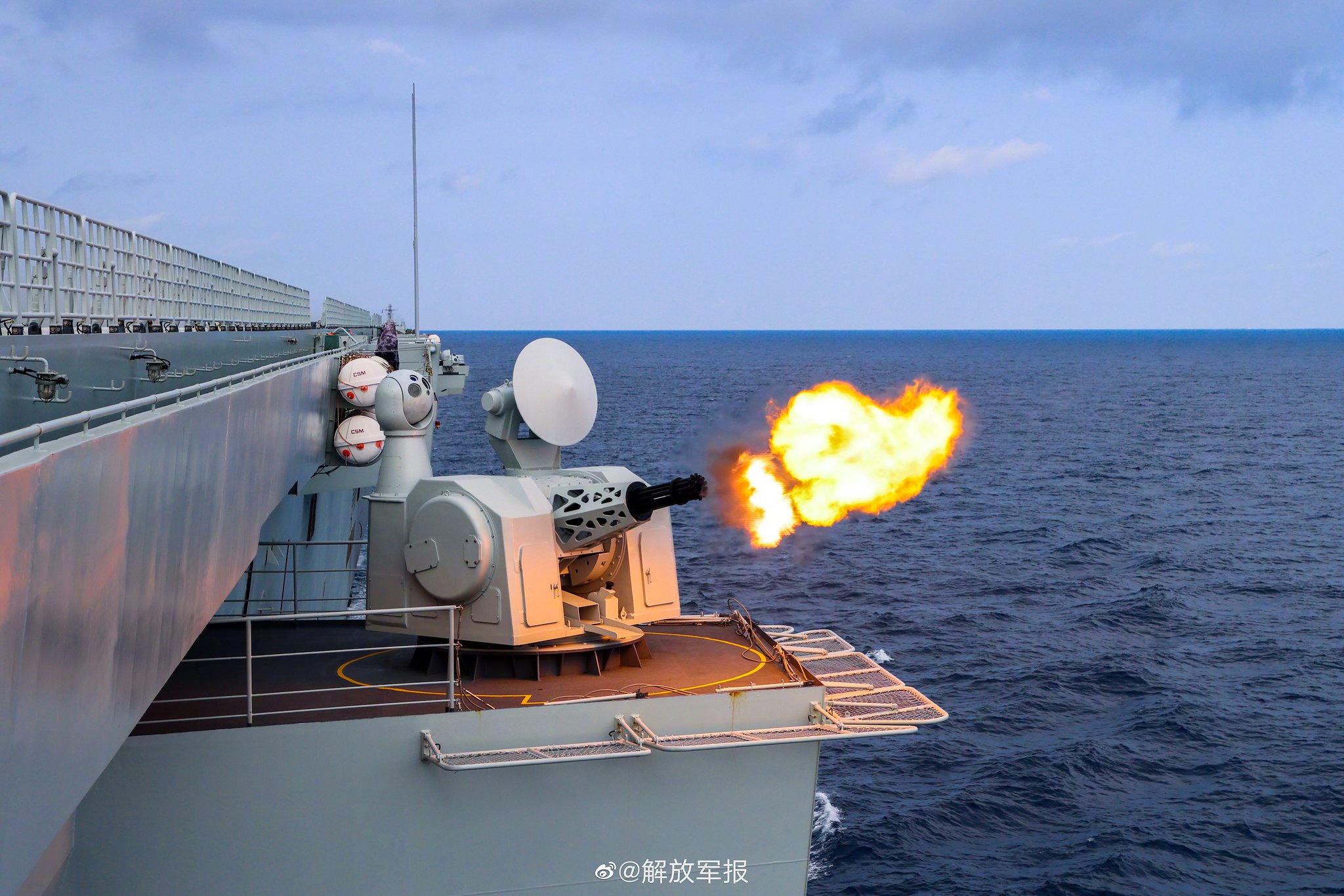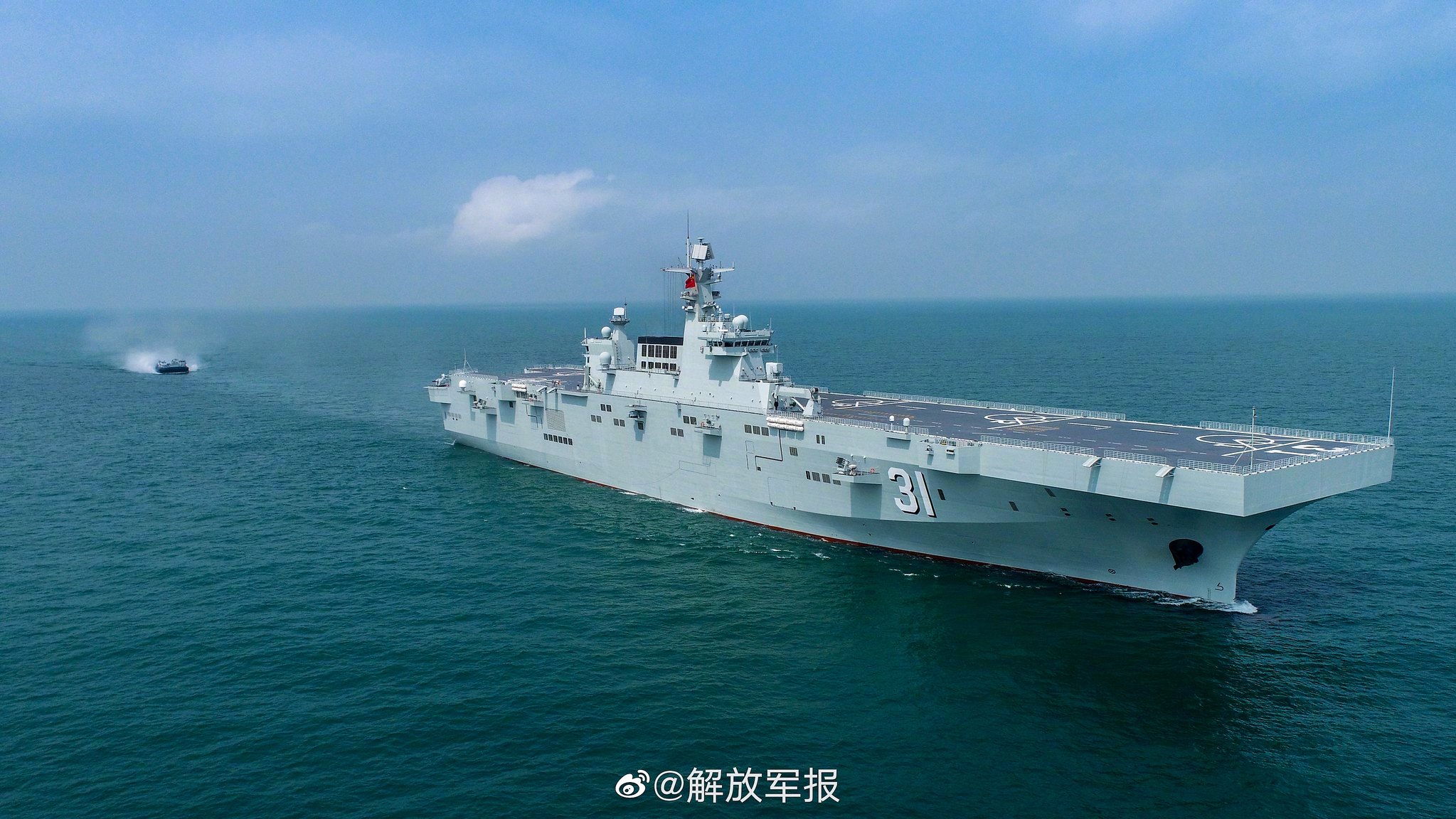the engine room looks shipshape and cleanHainan's engine room.


You are using an out of date browser. It may not display this or other websites correctly.
You should upgrade or use an alternative browser.
You should upgrade or use an alternative browser.
075 LHD thread
- Thread starter nosh
- Start date
LCACs are used for rapid delivery to landing zones.
I'm being pedantic here but ... LCACs are used for standoff, OTH amphib landings. LCACs and standard LCUs both cover ship-to-shore movement in about the same time but at vastly different distances. The LCAC platform speed is a product of the standoff+time requirement, not a speed/time requirement in itself.
Please understand that every feature of an amphib landing platform (welldeck vs none, LCAC vs LCU, Tilt Rotor vs Helo, AAVs vs LCs) is built around keeping the mothership as far away or spending as little time as possible in combat disembarkation.
defiantly only 1 MBT per LCAC and yes 4 MBT may sound limited but 4 x Type 071 LPD could land a 16 x MBT + infantry coming from Helicopters
There is combat landing and there is admin landing. MBTs and other heavies rarely come under combat landing unless under own power.
Also, you don't use Helos+Infantry for actual beach assault. They are used for blocking up the LOCs to resupply or reinforce the opfor at the beachhead. You could assault the beachhead from the rear with Heliborne troops but you'd face serious issues deconflicting your fire zones (if you have any amphib forces doing a beach landing as well).
I'm being pedantic here but ... LCACs are used for standoff, OTH amphib landings. LCACs and standard LCUs both cover ship-to-shore movement in about the same time but at vastly different distances. The LCAC platform speed is a product of the standoff+time requirement, not a speed/time requirement in itself.
Please understand that every feature of an amphib landing platform (welldeck vs none, LCAC vs LCU, Tilt Rotor vs Helo, AAVs vs LCs) is built around keeping the mothership as far away or spending as little time as possible in combat disembarkation.
Since we're being pedantic...
This is not how the original LCAC concept emerged. That role that came later with a general shift in amphibious doctrine which happened after the Cold War ended. In peer conflict OTH landing makes no difference. It became a factor in asymmetric conflicts afterward where AShM were a threat. Once OTH landings and sea-basing came into focus LCAC became the only viable means of delivery of vehicles and heavy cargo to landing zones in the initial stage of operation.
Landing Hovercraft are a Soviet doctrinal invention because USSR had three inland seas - Caspian, Baltic and Black - where amphibious operations could be performed from shore to shore. Large amphibious ships are for transporting forces over long distances at open sea. They require traditional hulls which prevent direct landing. Large hulls that allow disembarking are not good for sea travel. This means that the type of medium-sized amphibious ship that Soviet navy used like Ropucha or Alligator or Polnocny is useful only in specific conditions like the small inland seas at short distances. Polish Navy used such vessels as a transport to move vehicles to Norway for an exercise and it only worked because the troops weren't there. Several hours in such vessel at sea will exhaust the troops. This is why well-deck was invented allowing a large ship with good sea-keeping and ability to deploy landing craft.
Pr.1206 and Pr.12321 from 1970s were the first tank-carrying hovercraft:
They were considered successful and that led to medium-sized Pr.1206 Murena carrying one MBT and Pr.1232 Pomornik carrying three MBTs.
Soviets did not have "OTH" in their doctrine. These hovercraft replaced traditional hull ships due to speed and flexibility.
Hovercraft have a fundamental capability that makes them very good ship-to-shore connectors - they are much more independent of sea state and conditions at the shore.
People notoriously ignore environment as a factor. They also imagine a ship in water as a large heavy metal thing floating in soft liquid when the opposite is the truth. The large heavy metal ship is a vulnerable flimsy thing being thrown around by huge mass of water. The ship hitting the waves feels the same way as you would if you fell flat onto the surface of the pool. It's hard, it hurts and it can break things in your body. Moving through water at a speed is also as hard as swimming.
The ship-to-shore connectors are small vessels with minimal power because they have to fit inside the well deck and have to optimize for cargo space.That makes them very susceptible to bad seas. They're thrown around and struggle to move. Hovercraft on the other hand just glide across the water. To propel a ship with a propeller you have to put an engine, a shaft etc. That's heavy and it has to go at the bottom. The hovercraft is propelled by aircraft engines that can go anywhere as long as you can deliver sufficient thrust to create the air cushion.
The French attempted to resolve some of the issues with EDAR which is a catamaran with adjustable deck which can also serve as a planing hull. At sea it elevates the deck and gains speed and stability. Near shore it lowers the deck and increases hull area reducing draught.
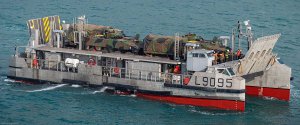
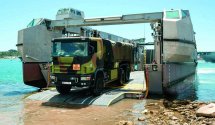
When a landing craft arrives at the shore the traditional boat is limited by its draught. This makes it very problematic to deliver heavy vehicles in shallow waters where the ground is too soft. Ideal shore has narrow beach and a drop-off. But many important locations barely stick out of the water and you can't come closer. The vehicles can't come. Soldiers have to use a boat. But a hovercraft can simply glide right onto the shore and disembark at a chosen location. If the recon is faulty the landing craft may need to maneuver before disembarking. It's difficult and slow for a boat, it's easy and fast for a hovercraft. This is also why amphibious armoured vehicles were invented. They can float thus making it easier to get them to the shore in shallow waters.
Pay attention to the size of the shallows in this atoll. The draught necessary to bring a tank onshore may simply be unachievable for a traditional hull.
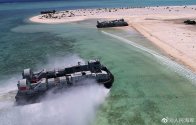
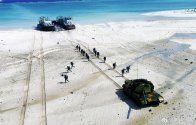
Obviously the hovercraft could go further if necessary.
The only problem with hovercraft is energy to payload ratio but that is calculated as part of the logistics of the operation.
As for helo vs rotorcraft - that came from USMC requirement for deep penetrating assault over land and not for keeping distance from the landing zone at sea. For example where in the Persian Gulf or the Red Sea is "over the horizon"? On the other hand being able to deploy the same force/payload at 2-3x the range with 2x the speed of a CH-53...
I've spent too much time here recently. I think that's a good time for a break. Take care.
Since we're being pedantic...
This is not how the original LCAC concept emerged. That role that came later with a general shift in amphibious doctrine which happened after the Cold War ended. In peer conflict OTH landing makes no difference. It became a factor in asymmetric conflicts afterward where AShM were a threat. Once OTH landings and sea-basing came into focus LCAC became the only viable means of delivery of vehicles and heavy cargo to landing zones in the initial stage of operation.
Landing Hovercraft are a Soviet doctrinal invention because USSR had three inland seas - Caspian, Baltic and Black - where amphibious operations could be performed from shore to shore. Large amphibious ships are for transporting forces over long distances at open sea. They require traditional hulls which prevent direct landing. Large hulls that allow disembarking are not good for sea travel. This means that the type of medium-sized amphibious ship that Soviet navy used like Ropucha or Alligator or Polnocny is useful only in specific conditions like the small inland seas at short distances. Polish Navy used such vessels as a transport to move vehicles to Norway for an exercise and it only worked because the troops weren't there. Several hours in such vessel at sea will exhaust the troops. This is why well-deck was invented allowing a large ship with good sea-keeping and ability to deploy landing craft.
Pr.1206 and Pr.12321 from 1970s were the first tank-carrying hovercraft:
They were considered successful and that led to medium-sized Pr.1206 Murena carrying one MBT and Pr.1232 Pomornik carrying three MBTs.
Soviets did not have "OTH" in their doctrine. These hovercraft replaced traditional hull ships due to speed and flexibility.
Hovercraft have a fundamental capability that makes them very good ship-to-shore connectors - they are much more independent of sea state and conditions at the shore.
People notoriously ignore environment as a factor. They also imagine a ship in water as a large heavy metal thing floating in soft liquid when the opposite is the truth. The large heavy metal ship is a vulnerable flimsy thing being thrown around by huge mass of water. The ship hitting the waves feels the same way as you would if you fell flat onto the surface of the pool. It's hard, it hurts and it can break things in your body. Moving through water at a speed is also as hard as swimming.
The ship-to-shore connectors are small vessels with minimal power because they have to fit inside the well deck and have to optimize for cargo space.That makes them very susceptible to bad seas. They're thrown around and struggle to move. Hovercraft on the other hand just glide across the water. To propel a ship with a propeller you have to put an engine, a shaft etc. That's heavy and it has to go at the bottom. The hovercraft is propelled by aircraft engines that can go anywhere as long as you can deliver sufficient thrust to create the air cushion.
The French attempted to resolve some of the issues with EDAR which is a catamaran with adjustable deck which can also serve as a planing hull. At sea it elevates the deck and gains speed and stability. Near shore it lowers the deck and increases hull area reducing draught.
View attachment 109947
View attachment 109948
When a landing craft arrives at the shore the traditional boat is limited by its draught. This makes it very problematic to deliver heavy vehicles in shallow waters where the ground is too soft. Ideal shore has narrow beach and a drop-off. But many important locations barely stick out of the water and you can't come closer. The vehicles can't come. Soldiers have to use a boat. But a hovercraft can simply glide right onto the shore and disembark at a chosen location. If the recon is faulty the landing craft may need to maneuver before disembarking. It's difficult and slow for a boat, it's easy and fast for a hovercraft. This is also why amphibious armoured vehicles were invented. They can float thus making it easier to get them to the shore in shallow waters.
Pay attention to the size of the shallows in this atoll. The draught necessary to bring a tank onshore may simply be unachievable for a traditional hull.
View attachment 109949
View attachment 109950
Obviously the hovercraft could go further if necessary.
The only problem with hovercraft is energy to payload ratio but that is calculated as part of the logistics of the operation.
As for helo vs rotorcraft - that came from USMC requirement for deep penetrating assault over land and not for keeping distance from the landing zone at sea. For example where in the Persian Gulf or the Red Sea is "over the horizon"? On the other hand being able to deploy the same force/payload at 2-3x the range with 2x the speed of a CH-53...
I've spent too much time here recently. I think that's a good time for a break. Take care.
Fair point. I realised that after posting that it was a bad example but couldn't be arsed to edit. Thanks for the explainer .Better example will probably be AAAV vs AAV
But a point to note, Russian amphib assets are typically designed for "inland seas" rather than blue water. They aren't quite case-in-point for general amphib.
by78
General
absolutely beautiful, a MBT on a Type 726 LCAC, railings of the LHD visible at the rear so its at the well deck
View attachment 109812
Already posted, literally on the previous page.
What is the point of an LHD like type 075 without VTOL? If its the ability to carry troops and armor, then an LPD will do the same function.
In this modern day with powerful air defense systems, using Helicopter for strikes on the shore seems like suicide. MANPADS and short range air defenses will easily take out helicopters. So, transporting troops for a shore assault with helicopters seems too risky.
LHD or Helicopter Carriers are popular these days in many countries because of the F-35B variant which provides a stealth 5th gen fighter that allows deep strike, fleet air defense and all the functions a carrier can do in a small and cheap package. So, even small military countries like Australia and UK can act like superpowers with light carriers.
Since China doesn't have a VTOL and probably no chance having a VTOL for many many years to come, why build something like an LHD with 20+ helicopters?
In this modern day with powerful air defense systems, using Helicopter for strikes on the shore seems like suicide. MANPADS and short range air defenses will easily take out helicopters. So, transporting troops for a shore assault with helicopters seems too risky.
LHD or Helicopter Carriers are popular these days in many countries because of the F-35B variant which provides a stealth 5th gen fighter that allows deep strike, fleet air defense and all the functions a carrier can do in a small and cheap package. So, even small military countries like Australia and UK can act like superpowers with light carriers.
Since China doesn't have a VTOL and probably no chance having a VTOL for many many years to come, why build something like an LHD with 20+ helicopters?
by78
General
What is the point of an LHD like type 075 without VTOL? If its the ability to carry troops and armor, then an LPD will do the same function.
In this modern day with powerful air defense systems, using Helicopter for strikes on the shore seems like suicide. MANPADS and short range air defenses will easily take out helicopters. So, transporting troops for a shore assault with helicopters seems too risky.
LHD or Helicopter Carriers are popular these days in many countries because of the F-35B variant which provides a stealth 5th gen fighter that allows deep strike, fleet air defense and all the functions a carrier can do in a small and cheap package. So, even small military countries like Australia and UK can act like superpowers with light carriers.
Since China doesn't have a VTOL and probably no chance having a VTOL for many many years to come, why build something like an LHD with 20+ helicopters?
Could you go troll somewhere else?
And where are these supposedly highly advanced short range air defenses in the US or its allies in the Pacific? Nowhere.In this modern day with powerful air defense systems, using Helicopter for strikes on the shore seems like suicide. MANPADS and short range air defenses will easily take out helicopters. So, transporting troops for a shore assault with helicopters seems too risky.
As for MANPADS, helicopters can be designed to be more resilient against MANPADS attacks. I think it is a matter of time until China starts devoting more attention to things like IR stealth and IR jamming. We already see tentative signs of this in the Z-10ME.
What deep strike? F-35B without catapults is highly limited in amount of payload it can carry and range as well. It can do fleet air defense, but it is a ginormous waste of money. Proposed Type 076 LHD with light catapult for drones makes a lot more sense.LHD or Helicopter Carriers are popular these days in many countries because of the F-35B variant which provides a stealth 5th gen fighter that allows deep strike, fleet air defense and all the functions a carrier can do in a small and cheap package. So, even small military countries like Australia and UK can act like superpowers with light carriers.
Because it makes sense in its theater of operations in the Pacific?Since China doesn't have a VTOL and probably no chance having a VTOL for many many years to come, why build something like an LHD with 20+ helicopters?
I have a similar question with respect to tamsen_ikard.
Helicopter carriers/light aircraft carriers often carry F-35B's. See Japan. The F-35B has STVOL (Short Take-Off and Vertical Landing).
The Type 075 never carries Chinese jets. China appears to lack the technology for STVOL - because of the engine?
How long would it take for China to develop STVOL? Some say it would take a long time? A Type 075 or Type 076 with a STVOL J-35 variant would be a pretty big deal.
Helicopter carriers/light aircraft carriers often carry F-35B's. See Japan. The F-35B has STVOL (Short Take-Off and Vertical Landing).
The Type 075 never carries Chinese jets. China appears to lack the technology for STVOL - because of the engine?
How long would it take for China to develop STVOL? Some say it would take a long time? A Type 075 or Type 076 with a STVOL J-35 variant would be a pretty big deal.

